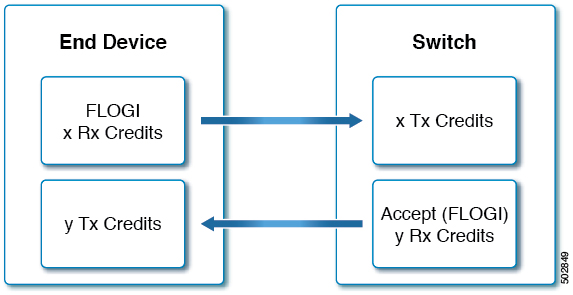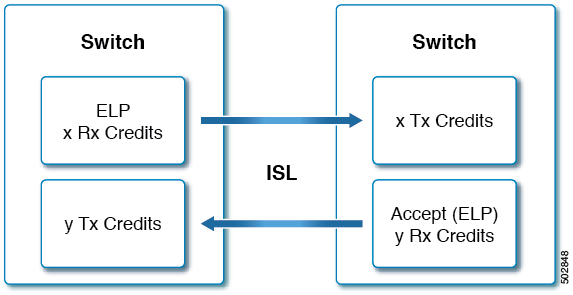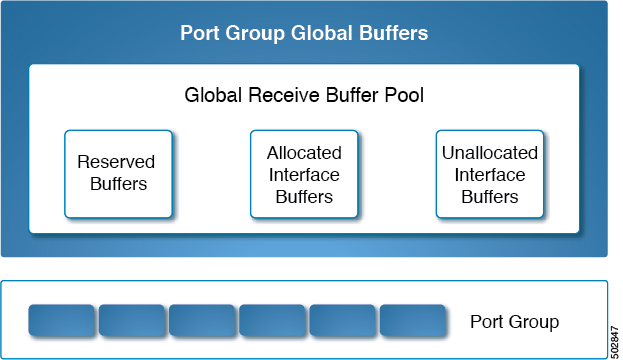Use the show interface counters detailed and the show logging onboard interrupt-stats commands to view the number of times a port sent extra R_RDYs or incremented transmit buffer to buffer credits to restore
credit counts:
switch# show logging onboard interrupt-stats
.
.
.
-------------------------------------------------------------------------------
INTERRUPT COUNTS INFORMATION FOR DEVICE: FCMAC
-------------------------------------------------------------------------------
Interface| | | Time Stamp
Range | Interrupt Counter Name | Count |MM/DD/YY HH:MM:SS
| | |
-------------------------------------------------------------------------------
fc1/1 |IP_FCMAC_INTR_ERR_BB_SCR_INCREMENT |1 |01/01/17 20:00:00
fc1/1 |IP_FCMAC_INTR_ERR_BB_SCS_RESEND |1 |01/01/17 10:00:00
.
.
.
The BB_SCR credit recoveries use the underlying IP_FCMAC_INTR_ERR_BB_SCR_INCREMENT counter and the counter indicates the number
of R_RDYs that were lost. The IP_FCMAC_INTR_ERR_BB_SCS_RESEND counter specifies the number of frames that were lost.
Use the show interface
port/slot
counters command to determine the interval the switch was unable to transmit frames since the counters were last cleared:
switch# show interface fc1/13 counters
.
.
.
6252650 2.5us Txwaits due to lack of transmit credits
.
.
.
Txwait value can be converted to seconds using the following formula:
TxWait value in seconds = ((TxWait value in 2.5 μs ticks) x 2.5)/(1,000,000)
Using this formula, we can see that the switch was unable to transmit frames for more than 15 seconds.
Use the show interface
port/slot
counters command to determine the duration for which the Tx BB credits were zero for the last 1 second, 1 minute, 1 hour, and 72 hours:
switch# show interface fc1/13 counters
.
.
.
Percentage Tx credits not available for last 1s/1m/1h/72h: 1%/5%/3%/2%
.
.
.
Use the show logging onboard txwait module
number command to check duration for which the remaining Txwait BB credits were zero over the span of 20 seconds:
switch# show logging onboard txwait module 2
---------------------------------
Module: 2 txwait count
---------------------------------
----------------------------
Show Clock
----------------------------
2019-04-08 13:56:52
Notes:
- Sampling period is 20 seconds
- Only txwait delta >= 100 ms are logged
--------------------------------------------------------------------------
| Interface | Delta TxWait Time |Congestion| Timestamp |
| | 2.5us ticks | seconds | | |
--------------------------------------------------------------------------
|Eth2/2(VL3)| 882562 | 2 | 11% | Tue Sep 11 08:52:34 2018|
|Eth2/1(VL3)| 4647274 | 11 | 58% | Tue Sep 11 08:52:14 2018|
|Eth2/2(VL3)| 7529479 | 18 | 94% | Tue Sep 11 08:52:14 2018|
|Eth2/1(VL3)| 7829159 | 19 | 97% | Tue Sep 11 08:51:54 2018|
|Eth2/2(VL3)| 7923544 | 19 | 99% | Tue Sep 11 08:51:54 2018|
|Eth2/1(VL3)| 5299754 | 13 | 66% | Tue Sep 11 08:50:34 2018|
|Eth2/2(VL3)| 362484 | 0 | 4% | Tue Sep 11 08:50:34 2018|
|Eth2/1(VL3)| 7924925 | 19 | 99% | Tue Sep 11 08:50:14 2018|
|Eth2/2(VL3)| 2566450 | 6 | 32% | Tue Sep 11 08:50:14 2018|
|Eth2/1(VL3)| 7935558 | 19 | 99% | Tue Sep 11 08:49:54 2018|
|Eth2/2(VL3)| 6762560 | 16 | 84% | Tue Sep 11 08:49:54 2018|
|Eth2/1(VL3)| 7908259 | 19 | 98% | Tue Sep 11 08:49:34 2018|
|Eth2/2(VL3)| 5264976 | 13 | 65% | Tue Sep 11 08:49:34 2018|
|Eth2/1(VL3)| 7925639 | 19 | 99% | Tue Sep 11 08:49:14 2018|
Use the show logging onboard error-stats command o list the ports with zero remaining Tx BB credits for 100 ms:
switch# show logging onboard error-stats
----------------------------
Module: 1
----------------------------
----------------------------
Show Clock
----------------------------
2018-08-28 12:28:15
---------------------------------
Module: 1 error-stats
---------------------------------
--------------------------------------------------------------------------------
ERROR STATISTICS INFORMATION FOR DEVICE: FCMAC
--------------------------------------------------------------------------------
Interface| | | Time Stamp
Range | Error Stat Counter Name | Count |MM/DD/YY HH:MM:SS
| | |
--------------------------------------------------------------------------------
fc7/2 |IP_FCMAC_CNT_STATS_ERRORS_RX_BAD_ |35806503 |03/17/19 11:32:44
WORDS_FROM_DECODER
fc7/2 |FCP_SW_CNTR_TX_WT_AVG_B2B_ZERO |2 |03/17/19 11:32:44
fc7/1 |FCP_SW_CNTR_TX_WT_AVG_B2B_ZERO |1 |03/17/19 11:32:44
fc7/15 |FCP_SW_CNTR_RX_WT_AVG_B2B_ZERO |1 |03/15/19 22:10:25
fc7/15 |FCP_SW_CNTR_RX_WT_AVG_B2B_ZERO |16 |03/15/19 18:32:44
fc7/15 |F16_TMM_TOLB_TIMEOUT_DROP_CNT |443 |03/15/19 15:39:42
fc7/15 |FCP_SW_CNTR_RX_WT_AVG_B2B_ZERO |12 |03/15/19 13:37:59
fc7/15 |FCP_SW_CNTR_RX_WT_AVG_B2B_ZERO |8 |03/15/19 13:29:59
fc7/15 |FCP_SW_CNTR_RX_WT_AVG_B2B_ZERO |4 |03/15/19 13:26:19
fc7/15 |FCP_SW_CNTR_RX_WT_AVG_B2B_ZERO |3 |01/01/17 13:12:14
fc7/15 |FCP_SW_CNTR_RX_WT_AVG_B2B_ZERO |25 |03/14/19 21:13:34
fc7/15 |FCP_SW_CNTR_RX_WT_AVG_B2B_ZERO |21 |03/14/19 21:06:34
fc7/15 |FCP_SW_CNTR_RX_WT_AVG_B2B_ZERO |17 |03/14/19 20:58:34
Use the show interface
port/slot
bbcredit command to verify BB credits information:
switch# show interface fc1/1 bbcredit
fc1/1 is up
Transmit B2B Credit is 16
Receive B2B Credit is 16
17 receive B2B credit remaining
16 transmit B2B credit remaining
Use the show interface
slot/port
bbcredit command to check for discrepency in the buffer-to-buffer credit values for a specific Fibre Channel interface:
switch# show interface fc2/1 bbcredit
fc2/1 is trunking
Transmit B2B Credit is 500
Receive B2B Credit is 500
Receive B2B Credit performance buffers is 0
500 receive B2B credit remaining
500 transmit B2B credit remaining
500 low priority transmit B2B credit remaining
500 low priority transmit B2B credit remaining
Use the show interface
port/slot
counters command to display the Tx and Rx BB credit transitions to zero information:
switch# show interface fc1/13 counters
.
.
.
33 Transmit B2B credit transitions to zero
394351077 Receive B2B credit transitions to zero
.
.
.
Use the show interface
port/slot
counters detailed command to check for credit loss recovery:

Note
|
-
In the show interface
port/slot
counters [detailed] command output, the Transmit B2B credit transitions to zero counter increments every time the transmit buffer-to-buffer credits goes to zero. When the ISLs are configured in the TX
credit double-queue mode using the system default tx-credit double-queue command, some TX B2B credits are reserved for high-priority traffic and remaining credits are used for low-priority traffic
from the total TX B2B credits configuration. Hence, when ISLs are in TX credit double-queue mode, this counter does not increment
though the low-priority credits go to zero because the high-priority credits are still available.
-
This command output is applicable for Cisco MDS NX-OS Release 8.4(2) and later releases. The command output varies if you
are using Cisco MDS NX-OS Release 8.4(1a) or earlier releases.
|
switch# show interface fc1/4 counters detailed
fc1/4
Rx 5 min rate bit/sec: 0
Tx 5 min rate bit/sec: 0
Rx 5 min rate bytes/sec: 0
Tx 5 min rate bytes/sec: 0
Rx 5 min rate frames/sec: 0
Tx 5 min rate frames/sec: 0
Total Stats:
Rx total frames: 9
Tx total frames: 21
Rx total bytes: 716
Tx total bytes: 1436
Rx total multicast: 0
Tx total multicast: 0
Rx total broadcast: 0
Tx total broadcast: 0
Rx total unicast: 9
Tx total unicast: 21
Rx total discards: 0
Tx total discards: 0
Rx total errors: 0
Tx total errors: 0
Rx class-2 frames: 0
Tx class-2 frames: 0
Rx class-2 bytes: 0
Tx class-2 bytes: 0
Rx class-2 frames discards: 0
Rx class-2 port reject frames: 0
Rx class-3 frames: 9
Tx class-3 frames: 21
Rx class-3 bytes: 716
Tx class-3 bytes: 1436
Rx class-3 frames discards: 0
Rx class-f frames: 0
Tx class-f frames: 0
Rx class-f bytes: 0
Tx class-f bytes: 0
Rx class-f frames discards: 0
Link Stats:
Rx Link failures: 0
Rx Sync losses: 0
Rx Signal losses: 0
Rx Primitive sequence protocol errors: 0
Rx Invalid transmission words: 0
Rx Invalid CRCs: 0
Rx Delimiter errors: 0
Rx fragmented frames: 0
Rx frames with EOF aborts: 0
Rx unknown class frames: 0
Rx Runt frames: 0
Rx Jabber frames: 0
Rx too long: 0
Rx too short: 0
Rx FEC corrected blocks: 0
Rx FEC uncorrected blocks: 0
Rx Link Reset(LR) while link is active: 0
Tx Link Reset(LR) while link is active: 0
Rx Link Reset Responses(LRR): 0
Tx Link Reset Responses(LRR): 1
Rx Offline Sequences(OLS): 0
Tx Offline Sequences(OLS): 1
Rx Non-Operational Sequences(NOS): 0
Tx Non-Operational Sequences(NOS): 0
Congestion Stats:
Tx Timeout discards: 0
Tx Credit loss: 0
BB_SCs credit resend actions: 0
BB_SCr Tx credit increment actions: 0
TxWait 2.5us due to lack of transmit credits: 0
Percentage TxWait not available for last 1s/1m/1h/72h: 0%/0%/0%/0%
Rx B2B credit remaining: 32
Tx B2B credit remaining: 16
Tx Low Priority B2B credit remaining: 16
Rx B2B credit transitions to zero: 1
Tx B2B credit transitions to zero: 2
Other Stats:
Zone drops: 0
FIB drops for ports 1-16: 0
XBAR errors for ports 1-16: 0
Other drop count: 0
Last clearing of "show interface" counters : never




 Feedback
Feedback